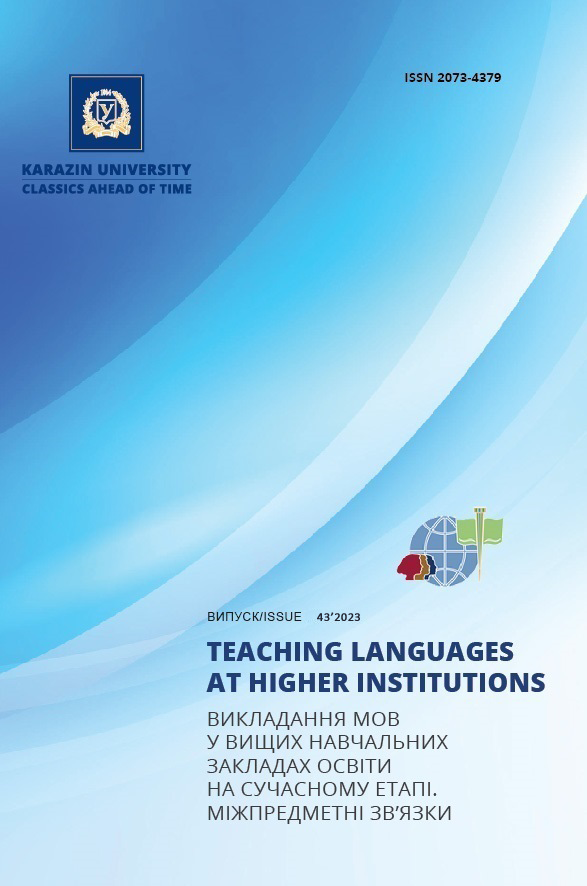Development of critical thinking in the process of improving productive communication skills
Abstract
The author addresses a crucial issue for higher educational institutions – the development of students’ critical thinking abilities. Every teacher in a higher educational setting, irrespective of their discipline, must both foster and cultivate students’ critical thinking skills within their classes. This is particularly vital for foreign language instructors. The article aims to substantiate the efficacy of implementing specific techniques aimed at enhancing students’ critical thinking within higher educational processes and to systematize these techniques for fostering critical thinking in foreign language classes, thereby enhancing productive skills such as speaking and writing.
Despite extensive scholarly exploration, the study of critical thinking, both in its general scope and various facets, remains an inexhaustible and vital field that will continue to evolve. Concerning the cultivation of critical thinking skills in the process of learning foreign languages, it is noteworthy that the breadth of research in this area remains vast. Within the communicative approach to foreign language learning, where lessons are designed to mirror real-life scenarios and involve constant comparison between one’s native language and the foreign language being learned, critical thinking must remain a constant presence.
While the techniques employed in receptive language skills (reading and listening) may be adequate, those used to develop critical thinking during sessions focused on refining productive language skills (speaking and writing) in higher education institutions require further enhancement. Consequently, a comprehensive analysis of this aspect of the broader issue demands ongoing attention. The article presents an exhaustive list of techniques applicable during sessions aimed at cultivating productive skills (speaking and writing), aligning them with specific critical thinking skills and the mental operations that accompany them.
Downloads
References
Bohdan, І.V. (2020). Vykorystannia tekhnolohii crytychnogo myslenia pry formuvani u shkoliariv comunicatyvnoi compitentsii na urokah angliiskoi movy [The use of critical thinking technology in the formation of schoolchildren’s communicative competence on English lessons]. All-Ukrainian scientific and practical conference “The specifics of teaching Ukrainian and foreign languages in school: theory and practice”. Kherson. Available at: https://genezum.org/library/vykorystannya-tehnologii-krytychnogo-myslennya-pry-formuvanni-u-shkolyariv-komunikatyvnoi-kompetentnosti-na-urokah-angliyskoi-movy [Accessed 01 Sept. 2023] [in Ukrainian].
Hembaruk, А.S., Bovhyria, О. Rozvytok crytychnogo myslenia uchniv na urokah inozemnoi movy [Development of students’ critical thinking during foreign language lessons]. Available at: https://dspace.udpu.edu.ua/bitstream/6789/9351/1/Gembaruk_Bovgyrya_Rozvytok_krytychnogo_myslennya_na_urokah_inozemnoyi_movy.pdf [ Accessed 01 Sept. 2023] [in Ukrainian].
Ivlievа, К, Rejdа, О, Gulievа, D. (2021). Technology implementation of critical thinking development in the process of teaching English in higher school. Foreign languages, 2, pp. 23–29. DOI: https://doi.org/10.32589/1817-8510.2021.2.235676 [in Ukrainian].
Кostiuchenkо, К.E. (2012). Іnteraktyvnі metody yak zasib formuvannia crytychnogo myslennia studentiv na zaniatiah z angliiskoi movy [Interactive methods as a means of forming students’ critical thinking during English classes]. Naukovi zapysky KDPU. Seria: Filolohichni nauky [Вulletin of V. Vinnichenko Kirovohrad Pedagogical University. Series: Philological Sciences]. 104, Part 2, pp. 388–391 [in Ukrainian].
Кorotка, N.V., Pidkolesnа, L.А. (2022). Formation of critical thinking technologies in learning English in a non-lingual university. Bulletin of Ostroh Academy National University: Philology Series, 16 (84), pp. 99–102. DOI: https://doi.org/10.25264/2519-2558-2022-16(84)-99-102 [in Ukrainian].
Каlynsка, H.V. (2018). Crytychne myslennia na urokah anhliiskoi movy [Critical thinking during English lessons.]. Каlynsка, H.V. (Comp.). Khmelnytskyi. Available at: https://naurok.com.ua/kritichne-mislennya-na-urokah-angliysko-movi-5346.html [Accessed 01 Sept. 2023] [in Ukrainian].
Kurinyi, О.V. (2023). Меtody rozvytku crytychnoho myslennia na urokah anhliiskoi movy u vyshchyh navchalnyh zakladah [Methods of developing critical thinking during English lessons in higher educational institutions]. Available at: https://repo.snau.edu.ua/bitstream/123456789/10840/1/.pdf [Accessed: 01 March 2023] [in Ukrainian].
Marynchenko, H.M., Motsak, S.I. (2021). Formuvannia crytychnoho myslennia studentiv pid chas dystantsiinoho navchannia [Formation of students’ critical thinking during distance learning]. International scientific journal “Grail of Science”. 4, pp. 463–467. DOI: https://doi.org/10.36074/grail-of-science.07.05.2021.083 [in Ukrainian].
Pelepeichenko, L.М., Revutskа, S.М., Babkov Yu.P. (2022). Сritical thinking foundations as a tool for manipulative technologies recognition. Honor and Law. Vol. 2, 81, pp. 112–119 [in Ukrainian].
Pometun, О.І. (2018). Critical thinking as a pedagogical phenomenon. Ukrainian pedagogic journal. 2, pp. 89–98. Available at: https://uej.undip.org.ua/index.php/journal/article/view/493/423 [Accessed 01 Sept. 2023] [in Ukrainian].
Revutskа, S.М. (2020). Тhe use of classroom routines in memorization and further development of communicative competence. Teaching languages at higher educational establishments at the present stage. Intersubject relations. 37, pp. 55–69. DOI: https://doi.org/10.26565/2073-4379-2020-37-06.
Nikitchenko, O.S., Tarasova, O.A. (2017). Formuvannia navychok krytychnoho myslennia na urokakh inozemnoi movy [Formation of critical thinking skills during foreign language lessons]. Kharkiv: “Drukarnia Madrid” [in Ukrainian].
Bloom, Benjamin S. (2001). A Taxonomy for Learning, Teaching, and Assessing: A Revision of Bloom’s Taxonomy of Educational Objectives. Lorin W. Anderson, David R. Krathwohl. L.: Longman,1st Edition.
Facione, P.A. (2015). Critical Thinking : What It Is and Why It Counts. Insight assessment. Available at: https://www.researchgate.net/publication/251303244_Critical_Thinking_What_It_Is_and_Why_It_Counts [Accessed 01 Sept. 2023].
Murawski, L. (2014). Critical Thinking in the Classroom…and Beyond. Journal of Learning in Higher Education. 10, pp. 25–30.
Nickname, Z., Royafar, A. (2019). Critical thinking skills of undergraduate students of educational sciences at Tehran universities. Utopía y Praxis Latinoamericana. Vol. 24, núm. Esp. 6, pp. 54–63. Available at: https://www.redalyc.org/journal/279/27962177007/html [Accessed 21 March 2023].
Ruggiero, V.R. (2012). The art of thinking: A guide to critical and creative thought (10th ed.). New York: Longman.

